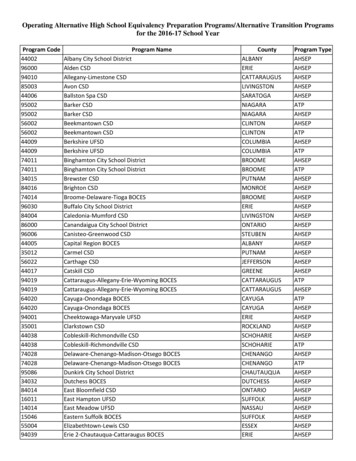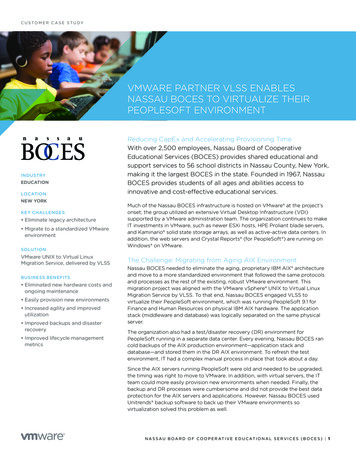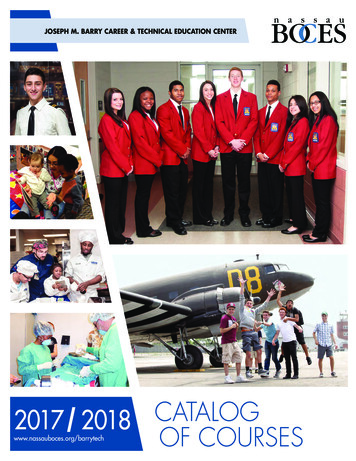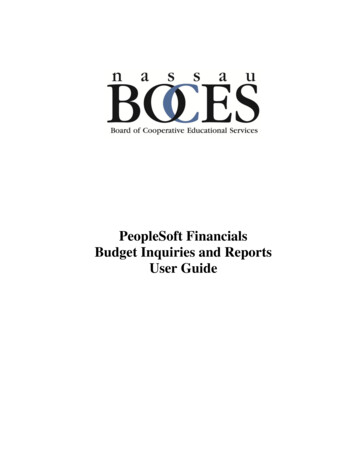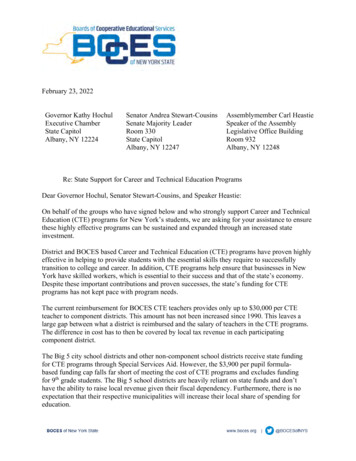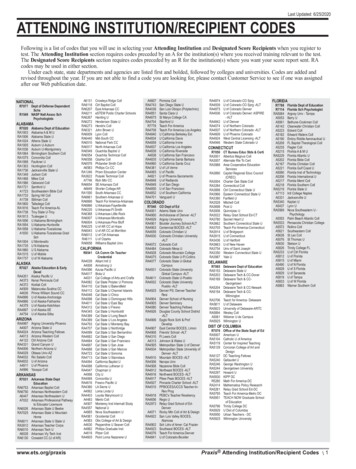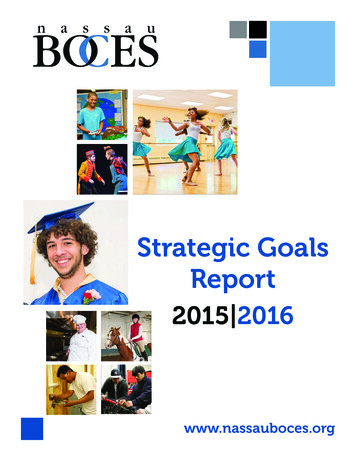
Transcription
Strategic GoalsReport2015 2016www.nassauboces.org
ForwardAt Nassau BOCES, our whole business is about makinga difference – for the districts we serve, in the lives ofour students and in education on Long Island. This isreflected in the Strategic Goals that guide our work: Ensure Student Success, Build the BOCES of the Future, Invest in Our Employees, Improve Long Island’s Regional Economy, and Work “Smarter,” Reduce Costs.This year, we made tremendous progress on a numberof these goals – from creating more efficiencies in ourbusiness practices to spearheading an initiative that willhave lasting impact on how Pre-K is delivered on LongIsland. As you will see throughout this document, crossdepartmental collaboration was critical to moving anumber of projects forward.I encourage all of you to read this report and as you do think about how our mission, visionand goals connect to you. Each of you – no matter what your role or connection to the agencyis – has the power to help Nassau BOCES reach its goals.Sincerely,Dr. Robert R. DillonDistrict SuperintendentThis report is based on a master set ofdata provided by Nassau BOCES’ sevendepartments: Business ServicesCurriculum, Instruction and TechnologyFacilities ServicesHuman ResourcesRegional Schools and InstructionalPrograms Special Education Strategic Initiatives
MissionTo partner with all Nassau County school districts in providing leadership and the highest qualityeducational and support services. We are committed to ensuring a successful, challenging, caringand safe environment that enables students of all ages and abilities to achieve their maximumpotential.VisionChanging Lives and Shaping the FutureValuesExcellenceIntegrityRespectStrategic GoalsEnsure Student SuccessBuild the BOCES of the FutureInvest in Our EmployeesImprove Long Island’s Regional EconomyWork ‘Smarter,’ Reduce Costs
Ensure Student SuccessHIGHLIGHTSCurriculum, Instruction and TechnologyContinue to develop the Center for Online Learning by: Enhancing the website/portal for content delivery; Establishing a collaborative workspace for creation anddelivery of instructional content; and Dedicating additional resources to supportand maintain the center.Regional Schools andInstructional ProgramsDevelop and use data system analytics and dashboardsto measure and improve: Program performance; Student achievement; and Fiscal/operational management. Instructional goals completed to include: Danielson Rubric;questioning and assessments; technology; CCLS and/orcollege required curriculum standards updating.Special EducationDay-to-day SupportSeek and/or expand partnerships with colleges,universities, medical and psychiatric facilities.Business Services – Budget and financing of programsCompare educational accomplishments of Nassau BOCESspecial education students with a national sample ofspecial education students, English Language Learnersand regular education students.Improve student achievement by gathering and analyzingdata to inform teaching and learning.Ensure all teaching and learning is aligned to the CommonCore Learning Standards.Facilities Services – Construction and maintenance ofinstructional spaceHuman Resources – Hiring and procedural undertakingsregarding staffStrategic Initiatives – Support as needed
Special Education increases collegecourse offerings and workplacetrainingWhat if someone believed you could? How much would you achieve?These simple questions led to a revolution inside the Department ofSpecial Education and the goals it sets for student achievement. Manypeople approach students with special needs based on what they can’t do.Our administrators and staff decided to believe in the potential of whatthese students could do instead. The outcome: college credits and jobpreparedness.When the department began offering college-bearing courses in 2013-14,110 students participated at three Nassau BOCES high school programs –Career Preparatory High School, Center for Community Adjustment and IrisWolfson High School. Twenty-five of those students earned credits. Now inits third year, 341 students are taking college courses. Sixty of them earnedcollege credit for their efforts and many of them are seeing for the first timethat they have a real chance for successfully attending college.Matthew Harford“We’re giving them the belief that they can do it,” said Dr. Joan Dituri, Assistant Director for Special Education.Matthew Harford, an Iris Wolfson High School student from Syosset UFSD, graduated this June with an AdvancedRegents Diploma and plans to attend CUNY Brooklyn in the fall. This year, he took Economics and Government throughNassau BOCES’ partnership with SUNY Farmingdale. He also took two virtual AP classes – Physics and Calculus. “Takingthese courses really prepared me for college,” said Matthew. “I like that getting credit in high school also frees up morespace in my college schedule.”Other students are benefiting from Special Education’s newly enhanced CareerDevelopment and Occupational Studies (CDOS) offerings. Students earningRegents and local diplomas are eligible to also receive CDOS certificates atgraduation. These job readiness and life skills courses are offered at both NassauBOCES middle schools – Willet Avenue and Seaman Neck – as well as the threehigh school programs mentioned above.Diamonique Middleton, a Center for Community Adjustment student fromFreeport UFSD, likes helping people and wants to pursue a career in cosmetologywhen she graduates. Each week, she and her fellow students have severalopportunities to participate in community-based work experiences.They help out at food pantries, with grounds maintenance and ice rink upkeep atthe Freeport Recreation Center and bag groceries at Fairway.Diamonique Middleton, front left, takes breakwith fellow CDOS students at the FreeportRecreation Center. Also pictured are RyanMarshall and Jenna Clark“At CCA, I have learned many skills needed for the world of work,” saidDiamonique. “We did many lessons in the classroom on how to be a goodemployee that someone would want to hire, and I took what I learned to all of ourcommunity worksites and applied those skills.”There are 16 CDOS courses offered throughout the department. Some examplesinclude Marketing-Hospitality/Tourism, Computer Applications, PersonalDevelopment, Retail Marketing and Life Skills.
Other Major AccomplishmentsCURRICULUM, INSTRUCTION AND TECHNOLOGYAdvances for Center for Online LearningThis year, the Center for Online Learning has a whole new look and feel – all designed to help improve the user experience and makereporting easier. Teachers and students access the Center for Online Learning content via a learning management system (LMS), whichwas completely overhauled this year.One of the new LMS features is individualized learning plans, which allow teachers to see when a student is struggling with a learningstandard and assign work to help strengthen their learning in that area. Students can also provide audio and video feedback. In addition,the center has adopted a new student information system designed specifically for blended or virtual learning environments. It can beused to send out automatic progress reports amongst many other features.Twenty-three districts participated in the Center for Online Learning during the 2015-16 school year. One of the most widely used servicesis virtual tutoring, in which certified teachers provide academic support. This year, districts participated in approximately 5,500 sessions.REGIONAL SCHOOLS AND INSTRUCTIONAL PROGRAMSUsing data to create better student successNumber crunching can impact student achievement. Just ask Jyoti Sood, Supervisor for Data andTechnology in the Department of Regional Schools and Instructional Programs. She uses data touncover student patterns and then helps teachers and school administrators use this information toimprove results.This year, Sood worked with Business Services to develop dashboards that track student absencesand grades. The absences dashboard highlights any students who have five or more absences inthe given marking period. It also shows their absences in previous marking periods. The gradesdashboard shows how students are doing compared to their classmates. “We are able to get apicture of issues for individual students and conduct a timely intervention,” said Sood.College credits for arts students expandedThe Long Island High School for the Arts [LIHSA] has partnered with multiple colleges and universities so that students can receivecollege credit for some of their high school arts courses. Dance students can earn credit for both their Art History, and Anatomy andKinesiology courses from Long Island University’s Post Campus. Theater students can earn credits in the History of Cinema, BeginningActing and Theatre History from Adelphi University and in Acting and Lighting Design from Queensborough Community College. LIHSAstaff members are approved adjunct professors for the partner colleges.BUSINESS SERVICESNature explore classroom opensOutdoor and Environmental Education’s new Nature Explore Classroom opened to students thisyear. Located at the Brookville Environmental Education Center, the outdoor classroom providesstudents of all ages with the perfect space to learn about renewable resources, simple machines,native vs. invasive plants and Long Island history.A variety of people helped to build the classroom, including naturalists, Barry Tech carpentrystudents, grounds staff, and other employees and their families.
Build the BOCES of the FutureHIGHLIGHTSRegional Schools and InstructionalProgramsCreate alignment between high school and adult careerand technical education programs.Expand partnerships and college credit opportunities withindustries and colleges and universities.Curriculum, Instruction and TechnologySeek program growth in: Technology Services, Digital Age Teaching and Education (Model Schools), and District security and technical projects.Launch new responsive website.Strategic InitiativesBusiness ServicesDeepen and expand relationships with regional leaders,community-based organizations and local funders.Develop dashboards that allow for better understanding ofNassau BOCES’ relationships with component districts.Create communications plan for upcoming referendas topurchase two buildings.Special EducationExpand partnerships and college credit opportunities withcolleges and universities.Expand relationship with Sagamore Children’s PsychiatricCenter.
Build the BOCES of the FutureIn-district alternativeprograms expandBorrowing from the highly successful Regional Summer School model,Nassau BOCES has slowly built a burgeoning new in-district programfocused on students who have trouble succeeding in the traditionalhigh school model. As was the case for Regional Summer School,the agency began this program by working with school districts whoalready had their own alternative program but wanted to reduce costsand improve student achievement.The Twilight Alternative High School allows districts to keep theprogram within their boundaries but share the costs of administrationwith other districts. This Regents-based program provides studentswith strong educational support, as classes are small and largelyfocused on the students. Sometimes the student is able to successfullyreturn to their daytime high school program while others continuein the twilight program until graduation as they prepare for postsecondary education or employment.Katherine DelValleDuring the 2015-16 school year, eight Nassau County school districts – Bellmore-Merrick CHSD, UniondaleUFSD, Massapequa UFSD, East Rockaway UFSD, Glen Cove UFSD, Freeport UFSD, Hicksville UFSD andSewanhaka UFSD — participated in this program. Another three districts will be implementing the programfor the 2016-17 school year.“I like working in smaller groups,” says eleventh-grader Katherine DelValle, of East Rockaway, who alsoattends Nassau BOCES Barry Tech each morning to study Culinary Arts. “This program is very different thanday school. There are fewer kids in the class, so there’s more individual attention. I’m never afraid to ask aquestion.”“The teachers really care about us in this program,” says eleventh-grader Colin Murphy. “The smaller classsize lets us get to know our teachers better, and we get whatever help we need.”“We’re delighted that the students in East Rockaway are responding so well to the Twilight Program,” saysKellie Cook McLaurin, Assistant Principal, Nassau BOCES Twilight Alternative High School. “This year, we’vetried to strengthen the partnership between the day school and the Twilight program, since these studentsattend both.”Nassau BOCES Twilight Program offers viable in-district educational options for students who thrive in a smallclassroom setting and need to focus on credit recovery. Students generally attend classes from 3 to 7 p.m.Nassau BOCES is also exploring a new twilight program at Barry Tech for English Language Learners. Gearedtoward students who are 16 and older and have scored a Level 2 on the New York State English as a SecondLanguage Achievement Test, this program may also offer the students a chance to participate in career andtechnical education courses at Barry Tech depending upon their skill level.
Other Major AccomplishmentsMULTI-DEPARTMENTALUtilize owned space more effectivelyThe Children’s Readiness Center Preschool Program was successfully relocated to the Joseph M.Barry Career &Technical Education Center. This strategic move was part of the agency’s plan toensure that all spaces owned by Nassau BOCES are utilized in the most effective way. The eastwing was redesigned to fit the needs of the preschoolers and their teachers, teacher aids and otherspecialty service providers that work with them.CURRICULUM, INSTRUCTION AND TECHNOLOGYBo-TIE fiber optic network completed early and under budgetFive years ago, Nassau BOCES embarked on one of its largest projects to date – a miles long fiber optic network connectingcomponent districts and providing them with access to significantly reduced phone and internet fees as well as enhanced services.In the end, 53 of Nassau County’s 56 school districts have signed on. Bo-Tie, as it is known, came in 2 million under budget – 4.85million original budget, 2.7 million projected at completion. This project was completely paid for by lease payments made for NassauBOCES educational television channels that were given to the agency in the 1960s.HUMAN RESOURCESHR Executive Director joins Civil Service advisory groupsEnsuring alignment between the Nassau County Civil Service (NCCS) agency and Nassau BOCESand its component districts is critical to proper staffing. This year, Tracey Nekulak, Executive Directorof Human Resources, was asked to join a new Human Resources Advisory Group. Through thisrole, Mrs. Nekulak hopes to develop an even stronger relationship with NCCS and help them tounderstand the hiring needs of Nassau BOCES and its districts. Presently, the group is looking intojob qualifications for a specific set of civil service positions. Similarly, two members of Curriculum,Instruction and Technology – Executive Director Anthony Carfora and Assistant Director ChristopherReinertsen – joined NCCS’ Technology Advisory Group in 2015.BUSINESS SERVICESIndustry leaders engaged in business-function user groupNearly 50 business professionals from throughout New York state gathered at the George FarberAdministrative Center to share their successes and strategies for using Cognos, IBM’s businessintelligence and performance management software suite, during a November 13 conference.Theevent was the first of its kind for the region, drawing attendees from the New York City Departmentof Education, Lower Hudson Regional Information Center, the Village of Garden City and the NassauCounty Department of Information Technology. Following the success of other Cognos user groupsacross the globe, the event featured presentations of new and developing technologies by expertsfrom IBM, as well as demonstrations of applications and best practices from the New York CityDepartment of Education and Nassau BOCES.Justin BroxtonBusiness Analytics Specialist IBM
Invest in Our EmployeesHIGHLIGHTSCurriculum, Instruction and TechnologyHold “Cohort” meetings for all department employees.Business ServicesDevelop dashboards to help make work easier and moreefficient.Provide website development staff with advanced training.Agencywide upgrades to new phone system and Windows10 operating system.Launch phase one of absence management project,including posting absence requests and balanceinformation online.Train specific employees to conduct more advanced work.Strategic InitiativesEncourage administrators to hold leadership roles in publicrelations associations and to make presentations at stateand national conferences.Provide professional development for email marketingplatform.Day-to-day SupportHuman Resources – Hiring and procedural undertakingsregarding staff, coordinates Mentor Teacher ProgramFacilities Services – Construction and maintenance ofinstructional and non-instructional spaces.
New dashboards make workeasier for staffNew dashboards make work easier for staffIt wasn’t Kelly Perkowski’s birthday when she saw the latest dashboardcreated to streamline business practices for Nassau BOCES, but it mightas well have been. It was the best present she got this whole year.As soon as the Principal Typist Clerk saw the prototype, she thought, “INEED this.” For the last five years, Perkowski has been responsible formanaging more than 500 consultant contracts and their accompanyingpurchase orders each year for CIT’s Curriculum and Instruction Service.Previously, she had to search five different areas of PeopleSoft, theBusiness Services and Curriculum Instruction and Technologyagency’s financial system, to gather all of the information she needed to(CIT) staff teamed up to develop dashboards to make work morekeep track of these consultants. Now, with the Purchase Order Inquiryefficient. Pictured are, back row from left, Don MacKenzie, KimDashboard, it’s all on one screen. The dashboard is set up to pull dataBaker, Cliff Steinberg and Larry Genova; and, front row, Andyfrom different areas of PeopleSoft as well as other platforms and create aAmarante and James Widmer.single source.This is just one of the tools being developed by the “Dashboard Team” that includes employees from both Business Services andCIT. As they develop these dashboards, the team is meeting with employees in various positions from throughout the agency whocould directly benefit and asking for input and feedback. James Widmer, Executive Director of Business Services, said that whenthe team is meeting with end users they have one basic question, “What can we give you on the screen that will make your workeasier?”Mary Stephens, who supervised the Languages Programs and Assessment Service (LPAS), is a big fan of the process and theresulting dashboard. “I love it,” she said. “I can get all of the information I need in one place.”LPAS works with more than 125 translators and other consultants. One of the dashboard features that was important to Ms.Stephens was the search function. She was able to provide input into the types of terms she searches for on a regular basis andthis was built into the system.“It saves time,” said Ms. Perkowski said of the dashboard. She has always dreaded the end-of-year process in which she has toclose out all of the year’s POs. In past, it has taken a week to complete. This year, she was able to do it in a day and a half.The dashboard also helps staff troubleshoot inquiries from vendors and consultants quickly. Say a vendor calls to find out thestatus of a payment. No problem. The status can be confirmed instantly just by opening the dashboard.Letter of Intent dashboardAnother dashboard making a big impact for staff tracks school districts’ commitment to participating in services for the next schoolyear. Each spring, districts submit this interest by using a Letter of Intent (LOI). In past, there was no easy way to monitor whatdistricts were signing up for and compare it to the previous school year.The new LOI dashboard allows assigned employees to see a lot of important information in one quick scan of the screen. Forexample, they can see which districts have finalized their LOIs, what new services the districts have signed up for, how manystudents are enrolled in a program and how that number differs from the previous year.“They no longer have to go into each district LOI individually,” said Andy Amarante, a member of the Dashboard Team whospearheaded the LOI dashboard. “They can see which programs are doing well and which are not quickly.”
Other Major AccomplishmentsCURRICULUM, INSTRUCTION AND TECHNOLOGYAgencywide updated phone system and Windows operating system in progressCIT is conducting two major agencywide projects to improve technology for employees. TheTelecommunications Service is replacing all telephones throughout the agency. The new systemoffers an agencywide directory of phone numbers, a call history on each phone, visual voicemail andcaller ID.Technology Services is beginning to roll out an upgrade to the Windows 10 operating system andOffice 2016 on all desktop computers – approximately 800 computers. Training started in the springand the project will continue throughout the next school year.BUSINESS SERVICESAbsence request reporting updatedBusiness Services has made it even easier for staff members to find out information about their absence requests and whether they havebeen approved. The agency’s printed timesheets now contain notations below each day’s entry if an absence has been requested andapproved. For example, if an employee requested a vacation day on June 2, that date would have a little X below it. More informationis also available online in the Employee Self Service’s new tab “Time Reporting.” Employees can now view their Absence RequestHistory and Leave Balances. Under Absence Request History, employees can see future requests and if they were approved, as well asthe history of their requests. Under Absence Balances, they can view balances for comp time, personal, sick, vacation, recess (z) and allpurpose days in one quick snapshot.STRATEGIC INITIATIVESNational presentations on crisis communicationsNassau BOCES’ PR team has been encouraged to share its expertise at local, state and national events. Executive Director LucindaHurley along with Public Information Officer Angela Marshall and Assistant Program Manager Theresa Scheafer traveled to Nashville,TN, to deliver a talk on Communicating Before, During and After a Natural Disaster. Ms. Marshall, who is President of the New YorkSchool Public Relations Association, delivered the same presentation to 70 school communicators at Capital Region BOCES. Thedepartment regularly mentors Hofstra University PR students, providing internships, and lectures on PR photography and the role of apublic information officer.SPECIAL EDUCATIONAlternative Assessment training for all Special Education staffSpecial Education Supervisor Patricia Schwetz facilitated a full-day training for all Nassau BOCESspecial education teachers who administer the new New York State Alternate Assessment, whichmoved to a computer-based model. She also provided this training to school district personnelthroughout the county – nearly 700 educators.
Improve Long Island’s Regional EconomyHIGHLIGHTSStrategic InitiativesBusiness ServicesParticipate in meetings and projects with a variety of LongIsland governmental, educational, business and fundingleaders to share recommendations and strategies relatedto working more effectively across Long Island, bridginggaps and bringing stakeholders together.Initiate an internship program with SUNY FarmingdaleState College.Serve as educational advisory member with organizationssuch as the Long Island Arts Alliance, Nassau County YouthBoard and Endless Dreams/Nassau County Department ofSocial Services.Work with other Long Island BOCES to seek grants andfunding opportunities on behalf of school districts.Utilize the Long Island Pre-K Initiative to help districtsimprove the quality of their Pre-K programs, leverageresources and receive their share of state and federalfunding streams.Curriculum, Instruction and TechnologyPublish bids for services and consumer products that allowdistricts to see reduced costs and bring business to LongIsland.Regional Schools and InstructionalProgramsCreate new Adult Education programs in areas where LongIsland industries say workers are needed.Special EducationDevelop and implement new course offerings to enableall Special Education students to obtain the Career andDevelopment and Occupational Studies CommencementCredential (CDOS).
Improve Long Island’s Regional EconomyAgency leads initiative to impactPre-K throughout Long IslandEarly childhood education experts from throughout Long Island havejoined together to consider a regional model for Pre-K. These effortsare being led by Nassau BOCES in partnership with Long Island’stwo other BOCES, Eastern Suffolk and Western Suffolk, as well as theChild Care Councils of Nassau and Suffolk counties. Called the LongIsland Pre-K Initiative, the group is focused on three main goals: improve the quality of Pre-K offered on Long Island through avariety of professional development for teachers andadministrators; to build stronger relationships between the school districts andthe center-based Pre-K providers on Long Island; and consolidation of regional models for delivery and support.“We have spent the last year building partnerships and learningwhat the real needs are on Long Island,” said Lucinda Hurley, a founder of the initiative and Nassau BOCES’ ExecutiveDirector for Strategic Initiatives. “The work that we do in the next year will be critical for deciding whether a regionalPre-K approach is needed and workable.”The initiative’s work could have lasting impact on the future of public education on Long Island. “Studies haveconsistently shown that high-quality Pre-K can significantly reduce the achievement gap,” said Ms. Hurley. “This canreduce the downstream cost of educating students in higher grades.”In addition, when publicly funded Pre-K is offered in a district or region, it supports families by reducing the costsassociated with childcare and frees parents to participate in the workforce.The partnership of the BOCES and child care councils is critical, according to Hurley. The BOCES have strongrelationships with the public schools and the child care councils are just as connected to the community-basedorganizations providing Pre-K throughout the island. Other important organizations have links to these main groups,including Long Island’s colleges and universities, publiclibraries, PTAs and the Parent-Child Home Program.“We are bringing together the island’s best thinkers onthis topic to ensure that what we recommend is not onlythe most appropriate solution for our children but is alsoachievable,” said Hurley.Long Island receives the lowest amount of publicfunding in the state for Pre-K. As part of its ongoingefforts, the initiative is working with legislativerepresentatives, the business community, earlychildhood advocates and other opinion leaders to makesure Long Island receives additional New York State andfederal funding for the region.Grant funding for the Long Island Pre-K Initiative isprovided by the Rauch and Hagedorn foundations.Both groups support organizations dedicated topromoting social equity and finding solutions throughthe exchange of ideas.
Other Major AccomplishmentsREGIONAL SCHOOLS AND INSTRUCTIONAL PROGRAMSNew Adult Education programs target healthcare and manufacturingBy this time next year, the EMT responding to a crisis near you might just be agraduate of Adult Education’s new Emergency Medical Technician (EMT) program.This is just one of several new programs being launched next year to meet workforceneeds on Long Island. Also starting this fall are programs for Advanced ClinicalMedical Assistant, Childhood Development Associate and Entry-level ManufacturingTraining.Nassau BOCES is partnering with Northwell Health, formerly North Shore-LIJ HealthSystem, on both of the new healthcare courses. EMT students will receive bothclassroom instruction and clinical/field experience in an ambulance tour. The ClinicalMedical Assistant program will prepare students for employment in medical offices,hospitals and labs. They will participate in a clinical internship and be able to sit forthree certification exams in EKG, Phlebotomy and Medical Assistant.Due to lack of qualified workers, local manufacturers asked Nassau BOCES to create the new entry-level manufacturing course. They saytheir new workers just don’t have the basics needed to be successful, according to Michele Cohen, Assistant Principal for Adult Careerand Technical Education. Students in this program will take courses such as blue print reading, quality control and shop math.As more districts begin to offer Pre-K for 3 and 4 year olds, there is a growing need for early childhood educators. The new ChildhoodDevelopment Associate course prepares students to fill this gap as well as provide qualified daycare workers and owners.BUSINESS SERVICES & CURRICULUM, INSTRUCTION AND TECHNOLOGYBusiness interns transition to employeesBusiness Services discovered more than one benefit to starting an internship program inpartnership with SUNY Farmingdale State College. Meet Sebastian DiPietro and ShivamVass. Both of them started out as interns and are now Nassau BOCES employees. And theyare not the only ones.When Long Island industry leaders talk about “the ones that got away,” they are often talkingabout talented young adults just like Mr. DiPietro and Mr. Vass, who are described as full ofenthusiasm and new ideas.
When the department began offering college-bearing courses in 2013-14, 110 students participated at three Nassau BOCES high school programs - Career Preparatory High School, Center for Community Adjustment and Iris Wolfson High School. Twenty-five of those students earned credits. Now in its third year, 341 students are taking college courses.

